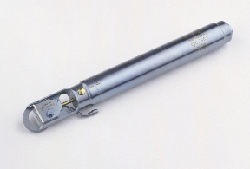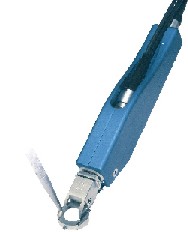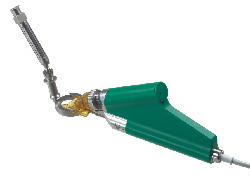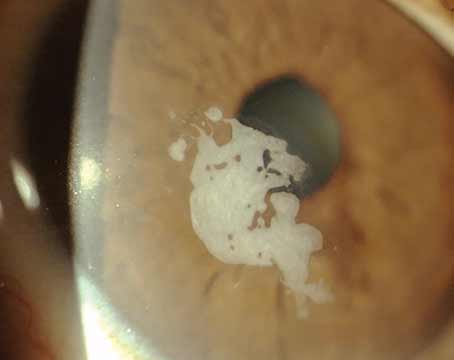As someone once said, nothing attracts a crowd like a crowd. Now it's starting to get crowded around the new refractive procedure on the block, epi-LASIK, as companies develop new devices for it. Here is a look at the attributes of the epithelial separators that are either approved for the procedure in the United States or will be soon.
Norwood's Centurion SES
Norwood Eyecare's Centurion was the first device approved in the United States for the epi-LASIK procedure.
The procedure, in summary, uses a relatively blunt edge to separate the epithelium down to, but not including, Bowman's membrane in an operation similar in appearance to a LASIK flap cut. This creates an epithelial sheet that can be moved out of the way for the laser ablation, then replaced to help foster re-epithelialization. All separators have a base unit connected to a handpiece that has a movable head that travels across the eye to make the epithelial sheet.
They also use a suction ring to facilitate the procedure, just as in LASIK.
Lamar Chandler, vice president of marketing for Norwood Eyecare, says the Centurion's plastic separator makes it unique. "It's a piece of plastic with a dull leading edge," he says. "It knows where the cleavage plane is. When it reaches Bowman's layer it can't go any deeper because it's just not sharp. It can't cut through, but only glide along the natural cleavage plane."
 |
| The Centurion SES allows surgeons to program the separator's oscillation and its speed across the cornea. |
Epithelial separators travel across the eye more slowly than microkeratomes, which, according to Mr. Chandler, gives better control over the separation. The Centurion moves across at 1.2 to 1.5 mm per second, a speed recommended by Norwood. This translation speed is programmable from the base station to go as high as 3 mm per second. The separator also oscillates at 12,000 rpm; this speed is also programmable.
To try to ensure that the separator won't nick stroma, Norwood has recently redesigned the suction ports on the posterior side of the suction ring to acquire vacuum more effectively. Mr. Chandler says this allows the separator to stay on the natural cleavage plane. The system has 9-mm and 10-mm suction rings.
"Typically, we're finding the 10-mm ring is used most widely because of the ablation zones, particularly here in the States," says Mr. Chandler. "Doctors are using the 10-mm ring because they get a larger ablation zone for use with some lasers, particularly the wavefront-guided procedures. We're using the 9-mm rings down in Mexico quite a bit and in Europe. What they're seeing is the 9-mm ring makes a smaller diameter epithelial sheet, which translates into quicker healing time, and avoids the limbal stem cells, which also contributes to a quicker healing time."
At press time, Norwood is running an "end-of-the-year" special on the system for $29,950 that includes two rings (both the same diameter or two different ones), the handpiece and the base unit. The usual list price is $62,000. The separators come in a box of 10 for $650. The tubing and the separator are disposable, and the suction ring and separator drive assembly are autoclavable.
VisiJet/Gebauer EpiLift System
The Gebauer EpiLift system (distributed by VisiJet, Irvine, Calif.) is U.S. FDA-approved and CE marked in Europe, and was introduced around 18 months ago, with most of the cases having been done in Europe.
Richard VanRyne, director of marketing and sales for VisiJet, says what makes the system unique is its applanator bar. "This means there's something in front of the separator that controls the tissue," he says. "You're not leading with the separator. The applanator flattens the epithelium in front of the separator, orienting the tissue the way you want it to effect epithelial separation."
 |
| The Gebauer EpiLift uses an applanator bar to help maintain an even epithelial separation. |
The EpiLift uses a metal epithelial separator, which Mr. VanRyne says isn't sharp, "but definitely isn't dull." The edge has a radius of curvature of 600 to 800 nm. "An epithelial cell itself is larger, about 1 µm," Mr. VanRyne says. "So, with the edge, called the SureEdge, being that small and fine, we think it can go beneath the epithelial cells and over Bowman's more reliably."
The surgeon can vary the size of the flap and hinge, as well as the oscillation rate of the separator from 6,000 to 10,000 rpm. VisiJet recommends 9,000 rpm oscillation. The speed of the head across the epithelium is fixed at a rate of 1 mm per second.
The EpiLift is based on the SKBM microkeratome platform, which was taken off the market by Alcon in 2002 due to problems with a glass applanation window that could come loose during surgery. Mr. VanRyne addresses these issues, saying, "The SKBM was a voluntary recall by Alcon. Gebauer had a fix for the problem immediately, and it was no longer going to come loose under any circumstances, but Alcon made the decision not to go through with that," he says. "They just wanted to exit the market. This wasn't an FDA recall. With this device, it does use the same power system and handpiece, but the heads are different."
The system costs $75,000, and comes with the base unit, the handpiece, disposable tubing, and the surgeon's choice of four of five varieties of suction rings designed to handle different K readings. The disposable separator costs $75.
Moria's Epi-K System
The Epi-K system is currently awaiting 510k approval in the United States.
The system uses a metal separator encased in a disposable plastic head. "By encasing the blade in the plastic head, we avoid it contacting other metal surfaces," says Don Mikes, Moria's vice president of marketing. "This minimizes the risk of inadvertently sharpening the edge and possibly cutting stroma." In addition, the system also has an applanation plate that's designed to prevent the separator from cutting into the stroma.
Since the blade head assembly is thrown away each time, he says sterilization issues don't arise, and it enhances convenience. The company plans to eventually have a disposable ring as well.
 |
| Moria's Epi-K system's metal blade is encased in plastic to avoid it's brushing metal and becoming sharp. |
Pricing hasn't been finalized yet, but Mr. Mikes estimates it will be around $65,000 for the system and two suction rings, and the disposable head/blade will be around $85. He hopes to launch the product in the United States in the first quarter of 2005.
"Another benefit we have, though intangible, is our company itself," says Mr. Mikes. "We are a highly-respected, established manufacturer in the refractive surgery market. I think that will be an important point when we go out and speak to surgeons about the Epi-K device."




